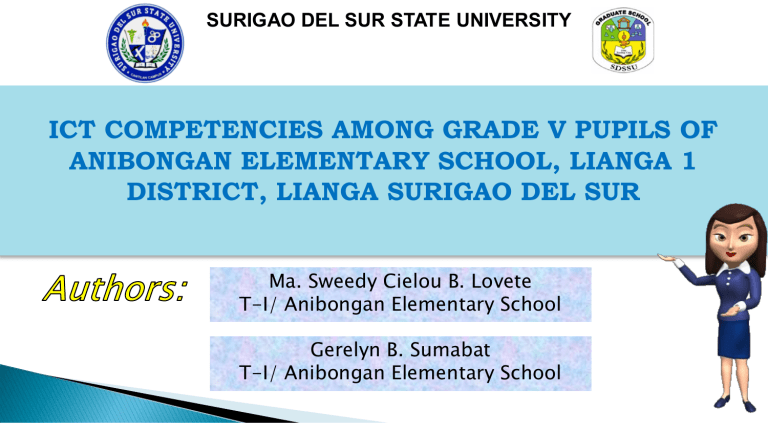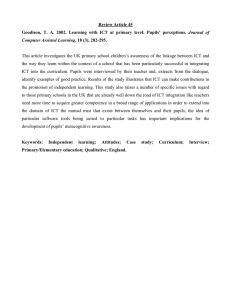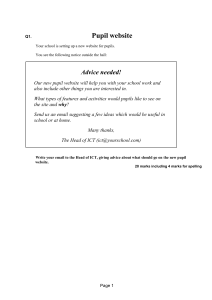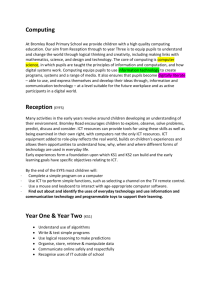
SURIGAO DEL SUR STATE UNIVERSITY ICT COMPETENCIES AMONG GRADE V PUPILS OF ANIBONGAN ELEMENTARY SCHOOL, LIANGA 1 DISTRICT, LIANGA SURIGAO DEL SUR Ma. Sweedy Cielou B. Lovete T-I/ Anibongan Elementary School Gerelyn B. Sumabat T-I/ Anibongan Elementary School Presentation’s Outline 1. Background of the Study 2. Conceptual Framework 3. Research Questions 4. Significance of the Study 5. Research Design 6. Findings 7. Conclusions 8. Recommendations 9. References Background of the Study ➢ Information and Communications Technology (ICT) refers to the range of technologies applied in the process of collecting, storing, editing, retrieving, and transfer of information in various forms. ➢ Danner and Pessu (2017) stated that the importance of technology in people’s lives is unimaginable. Similarly, Danner (2017 as cited by Singh and Subramaniam, 2018) says further that students would need computer and communication technology skills to live successfully in a knowledge-based society. ➢ Kennedy, et al. (2012 as cited by Guclu, 2019) noticed that many students do not have the knowledge, memory, learning, intelligence, or expertise to assess what they do and do not know and what they need to learn. Simply students “don’t know what they don’t know,” they are unable to recognize their exact level of competence. Thus, the purpose of this paper was to assess the Information and Communications Technology competencies among grade V pupils of Anibongan Elementary School. This is also to analyze the pattern of ICT usage habits and perceived competency possessed by grade V pupils of Anibongan Elementry School. Conceptual Framework . Research Questions The general objective of this study was to assess the Information and Communications Technology (ICT) competencies among pupils specifically grade V of Anibongan Elementary School of Lianga 1 District, Lianga, Surigao del Sur. It also sought to answer the following objectives: 1. Determine the profile of the respondents according to: a. Age b. Sex. 2. Identify the ICT usage habits of all grade V pupils of Anibongan Elementary School; 3. Identify the level of perceived ease towards ICT usage among grade V pupils of Anibongan Elementary School; 4. Examine how grade V pupils of Anibongan Elementary School perceive their ICT competencies; 5. Measure the significant differences in the perceived ICT competencies among grade V pupils of Anibongan Elementary School according to sex, age and ICT usage habits, and; 6. Establish whether there are significant differences in the perceived ease towards ICT usage among the grade V pupils of Anibnogan Elementary School according to age, sex, and ICT usage habits. Significance of the Study ▪ The following will benefit the study: ▪ Students ▪ Teachers ▪ Future Researchers Research Method Used Research Design ➢ This study used the descriptive survey method in identifying the Information and Communications Technology (ICT) competencies among grade V pupils of Anibongan Elementary of Lianga 1 District, Lianga, Surigao del Sur. Respondent ➢ The respondents of this study were all grade V pupils of Anibongan Elementary of Lianga 1 District Lianga, Surigao del Sur. The respondents answered the questionnaire given and follow an informal interview to make clarifications about the said research study. Research Instrument ➢ The data-gathering tool used was the questionnaire and informal interview. Data Gathering Procedure ➢ The respondents answered the questions according to the instruction provided. They indicated their responses by checking one of the five choices after each item. The data gathered were tallied, tabulated and subjected to analysis and interpretation. Data Analysis Plan In interpreting the data, the following measurements are used. Mean Value 4.24- 5.00 3.43- 4.23 2.62- 3.42 1.81- 2.61 1.00- 1.80 Description Strongly Agree Agree Neutral Disagree Strongly Disagree Statistical Treatment In analyzing the data, the following statistical measures employed. 1. To answer problem no. 1, 2, and 3, the frequency counts and percentage were used. 2. To answer problem no. 4 on the perception of grade V pupils of Anibnogan Elementary of Lianga 1 District students on their ICT competencies, mean was used; 3. To respond objective no. 5, and 6, the Analysis of Variance was used. 4.To further test in which group/s the difference exists, Post-Hoc Analysis was conducted using Tukey’s Pairwise Comparisons. Data were analyzed electronically using Paleontological Software Package (PAST), portable version and MS Excel 2013. Findings This investigation involved 25 grade V pupils of Anibongan Elementary of Lianga 1 District . Table 1 shows that for every (5) respondents, 4 were females or 80%. Only one-fourth of the respondents were males.. Findings Descriptive Profile of Respondents’ ICT Usage Habits Table 2. Respondents’ Distribution by Their ICT Usage Habits Group Computer Literacy Literate Illiterate Training Formal Non-Formal None Access to Computer School Home Internet Shop Access to Internet Yes No Frequency Percentage 22 3 25 88% 12% 100% 21 3 1 25 84% 12% 4% 100% 21 1 3 50 84% 4% 12% 100% 21 4 25 84% 16% 100% Findings Descriptive Profile of Respondents’ ICT Usage Habits Table 2. Respondents’ Distribution by Their ICT Usage Habits Frequency of Internet Use Never 1 4% Once a week 6 24% Several times a week 15 60% Daily 3 12% 25 100% Never 20 80% Weekly 0 0% Monthly 3 12% Daily 0 0% A few times a year 2 8% 25 100% Use of Emails Findings Findings Findings Table 5. Analysis of Variance on the Perceived ICT Competencies of Grade V Pupils According to Sex ICT Applications Word Processing p-value 0.2384 Decision Not Significant File navigation Net Browsing 0.3015 0.2675 Not Significant Not Significant Emailing 0.0232 Significant Presentation Tools 0.2821 Not Significant Overall 0.0525 Not Significant Level of Significance = 0.05 Remarks Males are better than females according to Tukey’s Pairwise Comparisons Findings ICT Applications Word Processing File navigation Net Browsing Emailing Presentation Tools Overall Level of Significance = 0.05 Table 6. Analysis of Variance on the Perceived ICT Competencies of Grade V Pupils According to Age p-value 0.5377 0.9326 0.4612 0.2916 0.5642 0.3691 Decision Not Significant Not Significant Not Significant Not Significant Not Significant Not Significant Findings Variable Sex Age Table 7. Analysis of Variance on the Perception on the Use of ICT Among Grade V Pupils of Anibongan Elementary School According to Sex and Age p-value 0.2539 0.4796 Decision Not Significant Not Significant Level of SignificanceLevel = 0.05 of Significance = 0.05 Table 8. Analysis of Variance on the Perception on the Use of ICT in the Grade V Pupils of Anibongan Elementary School According to ICT Usage Habits ICT Usage Habits p-value Decision Literacy Training Years of Use 0.7298 0.9542 0.5542 Not Significant Not Significant Not Significant Access to Computer 0.02837 Significant Access to Net Frequency of Net Use 0.543 0.5279 Not Significant Not Significant Conclusion ➢ The researchers came up with the conclusion on the Information and Communications Technology competencies among the grade V pupils of Anibongan Elementary School were ICT-capable and competent in different computer applications. Moreover, there are no significant differences on grade V pupils of Anibongan Elementary School perceived competencies on different ICT applications based on their age. ➢ Thus, grade V pupils of Anibongan Elementary School are equipped with enough knowledge, skills and right attitude towards information and communications technology in preparing them to be competitive graduates. References: References: THANK YOU FOR LISTENING MA. SWEEDY CIELOU B. LOVETE GERELYN B. SUMABAT





